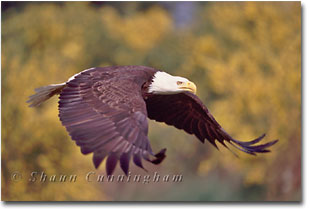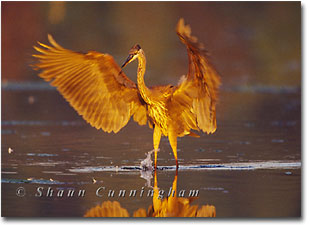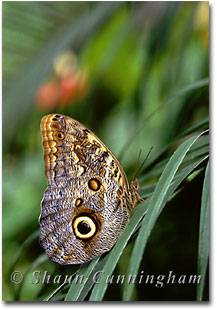|
|

Nature Close to Home
Text Copyright and Photography Copyright Shaun Cunningham
In my hometown, a city with an urban population of approximately 300,000 people, there are numerous locations where I can find a variety of nature subjects within a short distance of my home. The key word here is "short". In fact, many of my favorite images have been made at locales that required a drive of merely five minutes or so. I am sure that many readers can find themselves in similar circumstances. All it takes is a little time and effort to explore the possibilities surrounding you. Here are a few suggestions for you. Parks and Nature Sanctuaries Most cities and urban areas have parks that provide a suitable habitat for a surprising variety of animal life throughout the various seasons. By observing these areas frequently during the year, you will eventually gain insight into what species can be found on a regular basis. I find it helpful to keep a notebook of my observations for each location that I visit. A simple notation of the wildlife spotted, the date and the location, is ample information, although you can make your personal "nature book" as detailed as you desire. The goal is to have an easy reference guide to your favorite shooting sites available at your fingertips. Those with, pardon the pun, "photographic memories" can keep a mental checklist in their head. Although I also try to do this, I've found that keeping a written journal is by far the best method. When you visit areas such as city parks, be sure to arrive well before the majority of park visitors. I like to be in position before the sun comes up. During the summer months this means setting the alarm for a very early wakeup call. As fall turns into winter, you can catch a few more hours of slumber. There is always a gift awaiting those that make the extra effort to be out photographing before the crack of dawn. Nature's offering may not always result in a prizewinning image, but it will certainly renew your spirit and appreciation for all living things! Nature sanctuaries provide another splendid opportunity for great photographs. In many regions, small tracts of land have been set aside by state, provincial, and federal governments in order to provide habitat and safe haven for both resident and seasonal wildlife. There is an excellent series of "Wildlife Viewing Guides" available, that includes a listing of approximately 100 of the best sites in each state and province where birds and animals can be spotted. These books are quite comprehensive and give good information as to what species may be seen, along with the appropriate time frame in which to view them. At the present time they are not available for every state or province but the list is gradually growing. They are an indispensable aid and every ardent nature photographer should have the appropriate volume in his or her library. Wildlife Refuges
Many of the Wildlife Refuges also have a network of trails that enable one to pursue nature on foot. I have found however, that it is usually better to setup my gear at a suitable area and wait quietly for the creatures to come to me. If you locate yourself near a place where the birds and animals come to feed or drink, you will increase your odds of success. Some refuges actually have permanent blinds that can be utilized for just this purpose. Be sure to check with the refuge manager whether or not reservations will be necessary for the blind. Another alternative is to ask permission to use your own blind. Many refuges will grant you this request. Remember, a blind doesn't need to be elaborate to be effective. A simple piece of material draped over yourself and your equipment may be all that's needed. If you plan to spend most of the day in a blind you might require something with a little more comfort. In that case I recommend the Ultimate Blind offered by Leonard Rue Enterprises. The blind is roomy and will allow you to sit in comfort until you get the image you are after! Whenever you visit a wildlife refuge, you should get in the habit of speaking with the staff at the Visitor Center. The people are generally quite helpful and can provide you with reliable information and tips regarding the best spots to photograph any particular species. It also doesn't hurt to talk with other photographers and visitors at the refuge. Most folks are more than willing to share their wildlife sightings with you. By the same token, you should reciprocate with any information that you can share with others. When visiting any wildlife refuge, be sure that you abide by any rules of the area and that you conduct yourself in a manner that allows those who may follow the same privileges! Natural History Clubs and Rare Bird Alerts Many communities have local "Natural History Society" clubs that are often led by professional biologists. These groups hold meetings several times a month and are an excellent way to learn of different shooting locations in your area, along with a deeper understanding of your photographic subjects. They also go on field trips that will give you an opportunity to assess the pros and cons of various nature sites. Pay particular attention to the angle at which the light will strike the location during the peak times of early morning and late afternoon and evening. For most situations, you will usually want frontal lighting to bring out the best color and detail in your subject. Recently, I came across a great place to photograph a variety of waterfowl. The discovery was made via a phone call to the local "Rare Bird Alert" hotline. This service is available in many areas and consists of a recorded message that gives information on notable bird sightings and their location. The tape is updated every day or so and is a valuable tool for both birders and photographers. In this instance, the message prompted me to check out a small pond next to a golf course for a Wood duck that had been sighted. Sure enough, soon after my arrival, I spotted a gorgeous drake dressed in his "Sunday Best" plumage. Not only was there a Wood duck present, but there were an additional half dozen species represented, bringing the total number of waterfowl on the pond to approximately two hundred or so! One simple phone call resulted in the unearthing of a fantastic nature photography site less than 10 minutes drive from my home! Seasonal Activity In certain areas throughout North America, there are locations that become seasonally flooded resulting in wetland sites that support large numbers of waterfowl. For example, on the outskirts of my hometown there is an agricultural region that regularly floods every November during the rainy season. Each year, up to one hundred Trumpeter Swans visit this particular spot, along with Canada Geese and an assortment of other waterfowl. This congregation of birds also brings in a variety of raptors looking for an easy meal. Fortunately, access to this locale is quite good via public roads through the farmland. Other similar sites may require permission to enter private land. However, many farmers and landowners are very agreeable to a polite request from a conscientious photographer and will grant you access. Additionally, they can often provide you with useful knowledge regarding wildlife on their property.
If you live along the coast, river estuaries are another great spot to photograph nature. Along the West Coast, one can find bald eagles overlooking many estuaries during the annual fall salmon spawn. The eagles, along with numerous seagulls and black bears, are attracted to the easy and abundant carcasses of the dead and dying salmon. The spring and fall songbird migration is another example of such seasonal opportunities that may occur within a few minutes drive of one's home! Talk to birders and other photographers to find out where and when. Aquariums, Butterfly Gardens, Insectariums and Zoos Many towns and cities have one or more facilities such as aquariums, butterfly gardens, zoos, and even insectariums and reptile houses. These facilities offer a host of possibilities for the nature photographer and are usually open year round, rain or shine. In fact, what better way to utilize a wet and miserable day than by spending the day photographing comfortably under glass at a butterfly garden, or at the indoor exhibits at the zoo! I recommend that you buy a season's pass for each facility that you would like to photograph in. You will save money by doing this and will be more inclined to visit often. There is no better way to learn the various techniques required for nature photography than by practicing at such facilities.
While a full discussion on photographing at aquariums, zoos, etc. is beyond the scope of this article, here are a few tips to help get you started. First let's discuss the non technical tips-
Now let's list a few technical tips -
Your Own Backyard Last, but certainly not least, don't overlook your own backyard! By utilizing what al-ready exists on your own property one can create an environment that will host a sur-prising variety of subjects. The simple act of putting up a bird feeding station will enable you to photograph a number of different bird species, not to mention the squirrels that will probably find it! By erecting perches near the feeder you will have some control over where the birds will land, thus increasing your odds for a fine image. Old logs and tree branches are two suggestions of natural looking props for the birds to light on before feeding. The perch location should be carefully chosen with special attention paid to the angle of light, the background, and the distance from your equipment. Your backyard "nature studio" can be as simple or as elaborate as you wish and the setup listed above will certainly get you started. Should you decide to go further, you can landscape your property with trees, plants, and various flowers that will encourage an even greater variety of birds and creatures to pay you regular visits. The "National Wildlife Federation" publishes valuable information regarding this very topic, and your local library should provide ample fodder also. One word of caution: if you start feeding birds in the fall, you should continue throughout the winter. Don't leave them high and dry during this stressful period. The ideas and places that I've listed in this article should give you a good start in exploring your own local area. Each region is unique in what it has to offer, but rest assured that your territory has something of interest throughout the seasons. So, whether it's reptiles, birds, butterflies, or animals, take the time to explore the beauty of nature in your own surroundings! SOURCES OF INFORMATION AND EQUIPMENT
About the images… Bald Eagle in Flight (Haliaeetus leucocephalus) - Canon A2 with Canon 600mm. lens with 1.4x converter, 1/1000 at f5.6 on Bogen 3051 tripod with Wimberley Head. The film was Ektachrome Professional 200 rated at 250 and processed normally. Also made near a local lagoon on the outskirts of Victoria, British Columbia, Canada. Great Blue Heron Landing (Ardea herodias) - Canon A2 with Canon 600mm. lens with 1.4x converter, 1/125 at f5.6 on Bogen 3051 tripod with Wimberley Head. The film was Ektachrome Elite Extra Color 100 rated at 200 and pushed 2/3 of a stop. This image was made at a local lagoon in late summer near Victoria, British Columbia, Canada. Giant Owl Butterfly (Caligo eurilochus) - Canon A2 with Canon 80-200mm. zoom lens with 25mm. extension tube, 1/15 at f5.6 on Bogen 3021 tripod with Arca Swiss ballhead. Fill flash from a Canon 430EZ was used at -1 2/3 and the film used was Fujichrome Sensia 100 rated at 125 and processed normally. This image was made at Butterfly Gardens on the outskirts of Victoria, British Columbia, Canada. SC-NPN 129 Editor's Note - Be sure to visit Shaun's web site to view more of his work. Comments on this article? Send them to the editor. |
|
|
 We have all seen the wonderful images of birds and animals from around the world that are published with regularity in nature magazines, books, and calendars. How-ever, many of these creatures are quite exotic and require a considerable outlay in the form of cash, travel, and time to acquire quality photos of them. Even a two week jaunt to one of the National Parks to photograph more common species can set one back a sub-stantial amount of money, with no guarantee that the weather and animals will cooperate! For those who do not have the financial resources or the inclination to travel great distances, I would like to offer a satisfying alternative: get to know your own local area!
We have all seen the wonderful images of birds and animals from around the world that are published with regularity in nature magazines, books, and calendars. How-ever, many of these creatures are quite exotic and require a considerable outlay in the form of cash, travel, and time to acquire quality photos of them. Even a two week jaunt to one of the National Parks to photograph more common species can set one back a sub-stantial amount of money, with no guarantee that the weather and animals will cooperate! For those who do not have the financial resources or the inclination to travel great distances, I would like to offer a satisfying alternative: get to know your own local area! For those fortunate enough to live close to a National Wildlife Refuge, therein lies a veritable goldmine of possibilities. Many of these refuges have auto tour routes of varying lengths that allow the photographer access to diverse habitats within the refuge. Often, the wildlife has become habituated to the presence of vehicular traffic and will allow a slow and cautious approach. The best method to capture the animals on film is to remain in your vehicle and use some form of support for your telephoto lenses. A sturdy window mount system such as the Groofwin or Kirk Window Mount works well for the larger lenses, while a beanbag will provide ample support for shorter focal lengths. Some photographers even setup a tripod in their vehicles, although I've found this method somewhat cumbersome. Those with the new generation of Image Stabilized and Vibration Reduction lenses will find them ideal for shooting wildlife from a vehicle. Always turn the ignition off before shooting, and use the fastest shutter speed possible to maximize image sharpness. While your car does act like a blind to a certain extent, you still must be aware that any quick movement can spook the wildlife, so be patient and move slowly. A sheet of camouflage material over the passenger side window will mask your presence inside the vehicle.
For those fortunate enough to live close to a National Wildlife Refuge, therein lies a veritable goldmine of possibilities. Many of these refuges have auto tour routes of varying lengths that allow the photographer access to diverse habitats within the refuge. Often, the wildlife has become habituated to the presence of vehicular traffic and will allow a slow and cautious approach. The best method to capture the animals on film is to remain in your vehicle and use some form of support for your telephoto lenses. A sturdy window mount system such as the Groofwin or Kirk Window Mount works well for the larger lenses, while a beanbag will provide ample support for shorter focal lengths. Some photographers even setup a tripod in their vehicles, although I've found this method somewhat cumbersome. Those with the new generation of Image Stabilized and Vibration Reduction lenses will find them ideal for shooting wildlife from a vehicle. Always turn the ignition off before shooting, and use the fastest shutter speed possible to maximize image sharpness. While your car does act like a blind to a certain extent, you still must be aware that any quick movement can spook the wildlife, so be patient and move slowly. A sheet of camouflage material over the passenger side window will mask your presence inside the vehicle. There are numerous other potential hives of activity in your immediate vicinity. Those who live near the sea or a lake should look for gulls, shorebirds and waterbirds, just to name a few of the likely inhabitants you can expect to find. The habitat that surrounds rivers and streams can provide excellent opportunities for photographers. Creatures such as otter, mink, kingfisher, and osprey, along with many other species, frequent these prime wildlife areas.
There are numerous other potential hives of activity in your immediate vicinity. Those who live near the sea or a lake should look for gulls, shorebirds and waterbirds, just to name a few of the likely inhabitants you can expect to find. The habitat that surrounds rivers and streams can provide excellent opportunities for photographers. Creatures such as otter, mink, kingfisher, and osprey, along with many other species, frequent these prime wildlife areas.